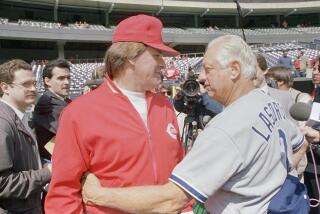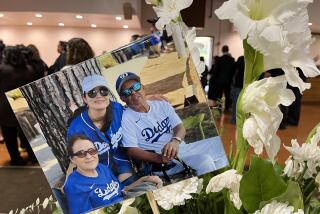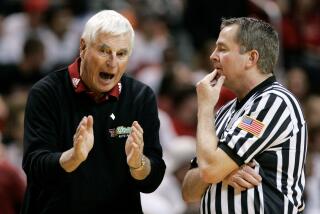Take a seat? Johnny Bench would rather not
- Share via
He was a baseball player with a contradictory name. In a 17-year Hall of Fame career with the Cincinnati Reds, Johnny Bench almost never sat on one.
Bench was a workhorse. Starting in 1967, and becoming arguably the best catcher ever, he played in 2,158 games, an average of 127 a season. That’s a lot of squatting.
He had his ways of communicating when enough was enough.
“We were playing the Dodgers in Cincinnati one time, and the game the night before had gone on until something like 1 in the morning,” Bench says. “Then, a few hours later, we were back out there, and it was hot. It’s late in the game, the Dodgers are up, 10-0, and our pitcher, Gerry Arrigo, is still trying to throw hard and can’t do it. If he keeps throwing what he is throwing, the game will go on for hours. So I give him the curve sign. He shakes it off. I put it down again. He says no. A third time. No.
“So I put down the fastball sign, he lets go, and I catch it with my bare hand. I look over in the Dodgers dugout and you can’t see a soul. The dugout was below ground at Crosley Field, and they were all rolling around on the ground, laughing.”
Similar stories are likely to tickle an audience of more than 1,500 attending Dennis Gilbert’s 9th annual Professional Baseball Scouts Foundation dinner Saturday night at the Century Plaza Hotel. Bench will be among the celebrities there as part of the program, and his stature alone could carry the show.
Bench turned 64 on Dec. 7, has had both hips replaced — “Best I’ve felt in 40 years,” he says — and is no longer a near-scratch golfer and occasional entrant on the Champions Tour. But if he is slowing down, it is only slightly. He has a son from a previous marriage who is 21, and has two other children, 5 and 2.
“I’m still traveling 50,000-70,000 miles a year, with appearances and speeches,” he says, “but with little kids, I’ve needed to cut back on that some.”
His trip into Los Angeles for the scouts dinner won’t be a long one. He lives part of the time at Mission Hills in Rancho Mirage and the rest in Naples, Fla.
His career, all with the Reds, included 14 All-Star Game selections, two Most Valuable Player awards and two World Series titles. In those days, his Cincinnati team was known as “The Big Red Machine.” While there were other key moving parts those days for Manager Sparky Anderson, such as Joe Morgan, Tony Perez and Pete Rose, Bench was the universal joint.
There are 13 catchers in the Hall of Fame, eight elected by the Baseball Writers Assn. and the other five by the Veterans’ Committee. “That’s about one a decade,” Bench says.
He remembers his induction, brought by a vote that had him on 96.2% of the ballots, on a very personal level.
“I didn’t go into the Hall of Fame,” he says. “My dad did.”
“We were in the hotel, and I remember walking out of the room and down the hall and running into Enos Slaughter.
“‘Just met your dad,’” Slaughter said.
“A few more steps and there is Pee Wee Reese, telling me the same thing. I turn the corner, and Ted Williams wants to tell me about meeting my dad and what a great guy he was. I get down to the lobby, and there is my dad. He’s got Roy Campanella in a headlock and they’re having just a grand old time.”
Bench’s memory is one of love. Ted Bench, a former semi-pro catcher who served two stints in the military, spanning eight years and starting in 1936, came home, drove a truck and spent as much time as he could getting the youngest of his three sons ready for a career in baseball.
And not just any career. One as a catcher.
“I played American Legion ball starting when I was 14,” Bench says. “But I didn’t catch until I was 17. I was 75-3 as a high school pitcher, but it was like everybody knew that I was supposed to be a catcher. When the scouts would come around and I was pitching, they’d make me take infield practice so the scouts could watch me throw.”
Bench is amused at how the game has changed, how managers call pitches from the dugout.
“In those days, the catcher did that,” he says. “I called every pitch and made most of the pitching changes. If I’d glance over at Sparky in a certain way, he’d know it was time to get somebody up in the bullpen. We’d go to the mound, and he’d look at me, and I’d tell him whether the guy was OK or not. That’s fair. The catcher is in the middle of everything. He sees it best.”
Another thing that has changed is the money. Bench, at age 35, says he was paid $900,000 in his final year in baseball, and walked away from a contract that had two years left and would have gotten him to the $1 million mark.
“I wasn’t Johnny Bench anymore,” he said. “The money was good, but I wasn’t earning it.”
Further proof that money isn’t everything was last summer’s Johnny Bench Day at The Great American Ball Park in Cincinnati. As part of the ceremony, they unveiled a statue of Bench.
“It just doesn’t get any better than that,” Bench says.
And they got it right. Bench’s statue is not sitting.
More to Read
Go beyond the scoreboard
Get the latest on L.A.'s teams in the daily Sports Report newsletter.
You may occasionally receive promotional content from the Los Angeles Times.











